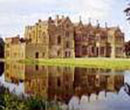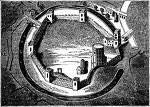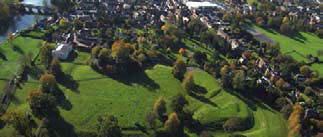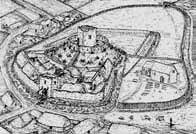Past Talks
Castles in Oxfordshire
Date: 22nd March 2005
Speaker: Trevor Rowley
The Meeting took place at The Pop-In Centre, Crown Walk, Bicester. Thirty four members and one dog attended.
Bob introduced the speaker, Trevor Rowley, who outlined the contents of his illustrated talk.
Few substantial remnants of castles remain in Oxfordshire compared with surrounding counties. Most castles sites are centred along the Thames Valley but their pattern of distribution reflects land ownership during the Middle Ages rather than defensive considerations. Castles tended to be built for private rather than public protection i.e. the safety of the Lord, his family and followers. Some initially used existing Roman walls or Saxon defensive sites as their strong points. William 1st planned to use Saxon organisational structures to rule the country following the Conquest but by 1070 A.D. had reconsidered following uprisings that occurred in the early part of his reign. He established castles in the shire capitals where taxes could be collected and justice dispensed e.g. Oxford. The fortifications protected the new Norman Lords who had replaced Saxon nobility and were used to intimidate the local population.




The first Norman castles were of a ‘Motte and Bailey’ variety. These were in use in France prior to the invasion and formed a pattern for castle construction in Britain. The Motte consisted of a mound, with a well as water source, and a tower placed on top of it. The Bailey consisted of a protected enclosure adjoining the Motte and housed the workshops, living quarters, stables etc. for the castle. Such castles are illustrated on ‘The Bayeux Tapestry’ and could be built quickly using local materials of turf and timber. Stone replaced timber constructions at a later stage. Large numbers of these castles were constructed on the Welsh borderlands and in South Wales. Many had a short life span and were not replaced. Wallingford and Oxford Castles were timber constructions at a time when William marched towards London, following the Battle of Hastings. He took a cautious approach in following a route that finally led to the occupation of London by way of Wallingford and the Chilterns.
Wallingford Castle, the best preserved castle site in Oxfordshire, developed from a Saxon Burh site and was where William negotiated the surrender of south east England, including Winchester, where the Treasury was located at that time. The castle was much smaller than at present but still covered a quarter of the town’s area. The castle remained important throughout the Middle Ages but was extended in the C12th. Saxon properties were covered by the castle structure and the road into the town diverted to accommodate the defence’s expansion. Excavations in 1970’s revealed the cob walls of the original town buildings beneath the fortifications. Stone was robbed from the site when the castle fell into disrepair as there was a shortage of natural stone in the county for building purposes.
Oxford Castle has been the site of recent important excavations, with Saxon structures revealed under the fortifications. St George’s Tower still remains, and is pre Conquest, being incorporated into the castle as it developed. A Crypt exists beneath the Tower. A significant mound was constructed and a large Bailey at the site. Marshy conditions formed a defensive barrier to the west and south of the castle and a stone causeway was built to cross the old ford at Grand Pont. The former prison on the site is currently being redeveloped.
Deddington Castle was extensive and contains a large Bailey. Originally owned by William’s half brother, Oddo, its size suggests that it might well have been used as an assembly point for troops when required. Situated on the outskirts of the village it is well away from the central core of the settlement. The castle was largely destroyed in C13th.
Chipping Norton Castle has an impressive raised enclosure. It was probably fairly important in its time.
Banbury Castle was excavated when the town centre was redeveloped in the 1970’s and lies to the north of the Market area.
Witney possesses a fortified Palace that was owned by the Bishops of Winchester. Close at hand is the site of Cogges which is a moated site once owned by Rabbard who appears on the Bayeux Tapestry.
Trevor excavated Middleton Stoney Castle some years ago. The site consisted of a low Motte and earthworks indicating a series of enclosures and Baileys. The Church, with a reconstructed Norman style Tower, was part of the site. Originally of a timber construction the castle was enhanced to have a stone Keep in the C12th although demolished a century later.
Many Oxfordshire castles were redundant by the end of the C12th. Their up keep was expensive. Moated Manor Houses later developed, more as a fashion statement rather than for defensive requirements e.g. Broughton Castle.
Trevor concluded his talk at 8:45 pm and responded to questions from the floor. Bob thanked the speaker for an interesting and informative talk. Refreshments were served after the Meeting.
